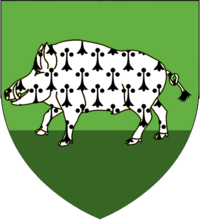Ó hAnluain
| Ó hAnluain | |
|---|---|
|
The Ó Hanlon, Lord of Orior |
|
| Parent house | Uí Nialláin (Síl Cernaich) |
| Titles |
|
| Founded | 4th century |
| Founder | Anluan |
The Ó hAnluain (anglicised as O'Hanlon) family was an agnatic extended family comprising one of a string of dynasts along the Ulster-Leinster border. Depending on the advantage to the sept, the named leader—The Ó Hanlon—supported either the Earl of Tyrone or authorities within the English Pale. During the 15th century, ties were close with the famed Earls of Kildare. Frequently, members of the sept would be on either side of a rebellion. Some would be outlawed; others pardoned; some ending up on the winning side.
They were second in the borderland line, east to west, comprising the followers of The Macgennis, The Ó Hanlon, The O'Neill of the Fews, The MacMahon, The O'Reilly and The O'Rourke. Behind the Ulster line were the lands of other septs, including those of The O'Neill and The O'Donnell.
The heart of "Ó Hanlon's Countrie" was centered on south central Ulster, much of it being in what is now the Republic of Ireland, beginning some 1,000 years ago. The oldest on record is Flaithbheartach Ua hAnluain, Lord of Ui Niallain, whose murder in the year 983 AD is recorded in the Annals of the Four Masters. The clan is documented in several of the earliest written histories of Ireland and appears in medieval tales, Elizabethan documents, the Plantation of Ulster, and traditional Irish songs.
The modern (anglicised) version of the name is usually given as Hanlon or O'Hanlon, but there are many variants: Handlon, Handlan, Hanlan, Hanlen, Hanlin, Hanlyn etc. Occasionally some variants of the names Hanly, and Handly are also derived from Ua hAnluain, although Hanly is usually the anglicised form of Ua hAinlighe, an ancient Roscommon sept (the oldest on record is Donal O'Hanly, Bishop of Dublin from 1085 to 1096).
The ancestors of the Ó hAnluain sept originated in the kingdom of Airgialla, centered on the modern-day County Monaghan with a capital at Clones. By the 5th century A.D. the sept held territory in and around the modern barony of O'Neilland, on the southwest shore of Lough Neagh. As the O'Neills rose in prominence from Dungannon to the west, the Ó Hanlons moved to territory west of Armagh City. For half a millennium, they served as kings of Orior. The chietain's name was synonymous with the territory which was better known as "Ó Hanlon's Country". It comprised about one-third of modern Co. Armagh, predominantly the eastern third, and also included a large tract of Co. Louth, from Faughart to Ravensdale, and then over the Cooley mountains to Omeath near Carlingford. The peak of land acquisition was in 1504; in 1505 the territory beyond the Gap of the North was granted to the Earl of Kildare. Two of the earliest maps of Ulster, Jobson's Ulster maps (c. 1590) and Norden's map of Ireland (1610), both show Ó Hanlon's Country. In 1586, when Sir John Perrot created the County of Armagh, Ó Hanlon's country accounted for one of the five baronies: Armaghe, Toaghriny, Orier, Fuighes (Fews) and Onylane (O'Neilland). In later times "Orier" became the Baronies of Orior Upper and Orior Lower, the southernmost two of Armagh's eight Baronies. It is often overlooked that the Gaelic territory of Orior predates and extended beyond the Barony of that name in County Armagh. Ó Hanlon's Country extended southwards into northern County Louth and to the East it encroached slightly into County Down. Before the county lines were finalised, some old maps show the old Ó Hanlon seat of Loughgilly in County Down.
...
Wikipedia

